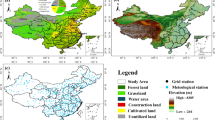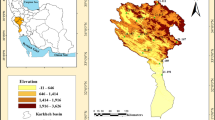Abstract
Drought is a complex natural phenomenon. To effectively characterize the spatial extent and intensity of the phenomenon, multiple drought-related factors, such as precipitation, vegetation growth condition, and land surface temperature, should be considered comprehensively. However, the capability of each of these factors in drought monitoring varies with seasonal time. Thus, in formulating a drought index, different weights should be assigned to these factors at different time periods. This study proposes a novel remote sensing index, the Integrated Drought Condition Index (IDCI), for short-term drought monitoring. The index sets different weights for each month of the growing season into three components, i.e., precipitation, vegetation growth condition, and land surface temperature, based on the principle component analysis. To assess IDCI performance, the spatial drought conditions of the IDCI maps during the growing season in a typical dry year and individual month of August from 2003 to 2012 were compared with in situ drought indices in Northern China. Correlation analyses were performed between the IDCI and different timescale Standardized Precipitation Evapotranspiration Index values, and the year-to-year IDCI variations were compared with in situ drought indices. The results of the comparison and correlation analysis confirmed the effectiveness of IDCI in characterizing drought conditions and patterns.








Similar content being viewed by others
References
American Meteorological Society (2013) An information statement of the American meteorological society on drought. https://www.ametsoc.org/policy/2013drought_amsstatement.html
AQSIQ (General Administration of Quality Supervision, Inspection and Quarantine of the People’s Republic of China), SAC (Standardization Administration of the People’s Republic of China) (2006) Classification of meteorological drought. In: Qiang Z, Xukai Z, Fengjin X (eds) State standardization of the People’s Republic of China, China Standards Publishing House, Beijing
Baert A, Villez K, Steppe K (2012) Functional unfold principal component analysis for automatic plant-based stress detection in grapevine. Funct Plant Biol 39(6):519–530
Bayarjargal Y, Karnieli A, Bayasgalan M, Khudulmur S, Gandush C, Tucker CJ (2006) A comparative study of NOAA-AVHRR derived drought indices using change vector analysis. Remote Sens Environ 105(1):9–22
Begueria S, Vicente-Serrano SM, Reig F, Latorre B (2014) Standardized precipitation evapotranspiration index (SPEI) revisited: parameter fitting, evapotranspiration models, tools, datasets and drought monitoring. Int J Climatol 34(10):3001–3023
Bhuiyan C, Singh RP, Kogan FN (2006) Monitoring drought dynamics in the Aravalli region (India) using different indices based on ground and remote sensing data. Int J Appl Earth Obs Geoinf 8(4):289–302
Bonaccorso B, Bordi I, Cancelliere A, Rossi G, Sutera A (2003) Spatial variability of drought: an analysis of the SPI in Sicily. Water Resour Manage 17(4):273–296
Boschetti M, Nutini F, Brivio PA, Bartholome E, Stroppiana D, Hoscilo A (2013) Identification of environmental anomaly hot spots in West Africa from time series of NDVI and rainfall. ISPRS J Photogramm Remote Sens 78:26–40
Caccamo G, Chisholm LA, Bradstock RA, Puotinen ML (2011) Assessing the sensitivity of MODIS to monitor drought in high biomass ecosystems. Remote Sens Environ 115(10):2626–2639
Carlson TN, Ripley DA (1997) On the relation between NDVI, fractional vegetation cover, and leaf area index. Remote Sens Environ 62(3):241–252
Chen J, Jönsson P, Tamura M, Gu Z, Matsushita B, Eklundh L (2004) A simple method for reconstructing a high-quality NDVI time-series data set based on the Savitzky-Golay filter. Remote Sens Environ 91(3):332–344
Dai AG (2011) Drought under global warming: a review. Wiley Interdiscip Rev Clim Change 2(1):45–65
Dai AG (2013) Increasing drought under global warming in observations and models. Nat Clim Change 3(1):52–58
Du L, Tian Q, Yu T, Meng Q, Jancso T, Udvardy P, Huang Y (2012) A comprehensive drought monitoring method integrating MODIS and TRMM data. Int J Appl Earth Obs Geoinf 23:245–253
Ezzine H, Bouziane A, Ouazar D (2014) Seasonal comparisons of meteorological and agricultural drought indices in Morocco using open short time-series data. Int J Appl Earth Obs Geoinf 26:36–48
Federal Emergency Management Agency (FEMA) (1995) National mitigation strategy—partnerships for building safer communities. FEMA, Washington, DC
Feng L, Hu CM, Chen XL (2012) Satellites capture the drought severity around China’s largest freshwater lake. IEEE J Sel Top Appl Earth Obs Remote Sens 5(4):1266–1271
Gebrehiwot T, van der Veen A, Maathuis B (2011) Spatial and temporal assessment of drought in the Northern highlands of Ethiopia. Int J Appl Earth Obs Geoinf 13(3):309–321
Gu Y, Brown JF, Verdin JP, Wardlow B (2007) A five-year analysis of MODIS NDVI and NDWI for grassland drought assessment over the central great plains of the United States. Geophys Res Lett 34(6):186–192
Guttman NB (1998) Comparing the palmer drought index and the standardized precipitation index. J Am Water Resour Assoc 34(1):113–121
Guttman NB (1999) Accepting the standardized precipitation index: a calculation algorithm. J Am Water Resour Assoc 35(2):311–322
Hmimina G, Dufrene E, Pontailler JY, Delpierre N, Aubinet M, Caquet B, de Grandcourt A, Burban B, Flechard C, Granier A, Gross P, Heinesch B, Longdoz B, Moureaux C, Ourcival JM, Rambal S, Saint Andre L, Soudani K (2013) Evaluation of the potential of MODIS satellite data to predict vegetation phenology in different biomes: an investigation using ground-based NDVI measurements. Remote Sens Environ 132:145–158
Jiang D, Fu JY, Zhuang DF, Xu XL (2013) Dynamic monitoring of drought using HJ-1 and MODIS time series data in northern China. Nat Hazards 68(2):337–350
Keshavarz MR, Vazifedoust M, Alizadeh A (2014) Drought monitoring using a Soil Wetness Deficit Index (SWDI) derived from MODIS satellite data. Agric Water Manage 132:37–45
Kogan FN (1990) Remote sensing of weather impacts on vegetation in non-homogeneous areas. Int J Remote Sens 11(8):1405–1419
Kogan FN (1995) Application of vegetation index and brightness temperature for drought detection. Adv Space Res 15(11):91–100
Kogan F, Salazar L, Roytman L (2012) Forecasting crop production using satellite-based vegetation health indices in Kansas USA. Int J Remote Sens 33(9):2798–2814
Kogan F, Adamenko T, Guo W (2013) Global and regional drought dynamics in the climate warming era. Remote Sens Lett 4(4):364–372
Lasaponara R (2006) On the use of principal component analysis (PCA) for evaluating interannual vegetation anomalies from SPOT/VEGETATION NDVI temporal series. Ecol Model 194(4):429–434
Li B, Liang Z, Yu Z, Acharya K (2013) Evaluation of drought and wetness episodes in a cold region (Northeast China) since 1898 with different drought indices. Nat Hazards 71(3):2063–2085
Liu W, Kogan F (1996) Monitoring regional drought using the vegetation condition index. Int J Remote Sens 17(14):2761–2782
Liu WP, Holst J, Yu ZR (2014) Thresholds of landscape change: a new tool to manage green infrastructure and social-economic development. Landsc Ecol 29(4):729–743
Malingreau JP (1986) Global vegetation dynamics—satellite-observations over Asia. Int J Remote Sens 7(9):1121–1146
McKee TB, Doesken NJ, Kleist J (1993) The relationship of drought frequency and duration to time scales. In: Proceedings of the 8th conference on applied climatology, vol. 17. pp 179–183
Palmer WC (1965) Meteorological droughts. U.S. Department of Commerce Weather Bureau Research Paper 45
Park S, Feddema JJ, Egbert SL (2004) Impacts of hydrologic soil properties on drought detection with MODIS thermal data. Remote Sens Environ 89(1):53–62
Peters AJ, Walter-Shea EA, Ji L, Vina A, Hayes M, Svoboda MD (2002) Drought monitoring with NDVI-based standardized vegetation index. Photogramm Eng Remote Sens 68(1):71–75
Raziei T, Bordi I, Pereira LS (2008) A precipitation-based regionalization for Western Iran and regional drought variability. Hydrol Earth Syst Sci 12(6):1309–1321
Rhee J, Im J, Carbone GJ (2010) Monitoring agricultural drought for arid and humid regions using multi-sensor remote sensing data. Remote Sens Environ 114(12):2875–2887
Rouse JW, Hass RH, Schell JA, Deering DW (1974) Monitoring vegetation systems in the great plains with ERTS. In: Proceedings of the 3rd earth resources technology satellite-1 symposium, NASA, Greenbelt, pp 309–317
Santos JF, Pulido-Calvo I, Portela MM (2010). Spatial and temporal variability of droughts in Portugal. Water Resour Res 46(3):742–750
Seiler RA, Kogan F, Wei G (2000) Monitoring weather impact and crop yield from NOAA AVHRR data in Argentina. Adv Space Res 26(7):1177–1185
Shahabfar A, Ghulam A, Eitzinger J (2012) Drought monitoring in Iran using the perpendicular drought indices. Int J Appl Earth Obs Geoinf 18:119–127
Sohn SJ, Ahn JB, Tam CY (2013) Six month—lead downscaling prediction of winter to spring drought in South Korea based on a multimodel ensemble. Geophys Res Lett 40(3):579–583
Son NT, Chen CF, Chen CR, Chang LY, Minh VQ (2012) Monitoring agricultural drought in the Lower Mekong Basin using MODIS NDVI and land surface temperature data. Int J Appl Earth Obs Geoinf 18:417–427
Stagge JH, Tallaksen LM, Gudmundsson L, Van Loon AF, Stahl K (2015) Candidate distributions for climatological drought indices (SPI and SPEI). Int J Climatol. doi:10.1002/joc.4267
State Flood Control and Drought Relief Headquarters (SFCDRH) and Ministry of Water Resources of the Government of the People’s Republic of China (2011) Gazette of China’s flood and drought disasters in 2009, Gazette of the Ministry of Water Resources of the People’s Republic of China, vol 1. pp 14–30
Tadesse T, Wilhite DA, Harms SK, Hayes MJ, Goddard S (2004) Drought monitoring using data mining techniques: a case study for Nebraska USA. Nat Hazards 33(1):137–159
Tadesse T, Brown JF, Hayes MJ (2005) A new approach for predicting drought-related vegetation stress: integrating satellite, climate, and biophysical data over the US central plains. ISPRS J Photogramm Remote Sens 59(4):244–253
Thornthwaite CW (1948) An approach toward a rational classification of climate. Geogr Rev 38(1):55–94
Vicente Serrano SM, González-Hidalgo JC, Luis MD, Raventós J (2004) Drought patterns in the Mediterranean area: the Valencia region (eastern Spain). Clim Res 26(1):5–15
Vicente-Serrano SM (2006) Differences in spatial patterns of drought on different time scales: an analysis of the Iberian Peninsula. Water Resour Manage 20(1):37–60
Vicente-Serrano SM, Begueria S, Lopez-Moreno JI (2010a) A multiscalar drought index sensitive to global warming: the standardized precipitation evapotranspiration index. J Clim 23(7):1696–1718
Vicente-Serrano SM, Begueria S, Lopez-Moreno JI, Angulo M, El Kenawy A (2010b) A new global 0.5 degrees gridded dataset (1901–2006) of a multiscalar drought index: comparison with current drought index datasets based on the Palmer Drought Severity Index. J Hydrometeorol 11(4):1033–1043
Wang W, Zhu Y, Xu RG, Liu JT (2015) Drought severity change in China during 1961–2012 indicated by SPI and SPEI. Nat Hazards 75(3):2437–2451
Xia JS, Du PJ, He XY, Chanussot J (2014) Hyperspectral remote sensing image classification based on rotation forest. IEEE Geosci Remote Sens Lett 11(1):239–243
Xiong J, Wu BF, Yan NN, Zeng YA, Liu SF (2010) Estimation and validation of land surface evaporation using remote sensing and meteorological data in North China. IEEE J Sel Top Appl Earth Obs Remote Sens 3(3):337–344
Yu M, Li Q, Hayes MJ, Svoboda MD, Heim RR (2014) Are droughts becoming more frequent or severe in China based on the Standardized Precipitation Evapotranspiration Index: 1951–2010? Int J Climatol 34(3):545–558
Zhang AZ, Jia GS (2013) Monitoring meteorological drought in semiarid regions using multi-sensor microwave remote sensing data. Remote Sens Environ 134:12–23
Zheng D, Li B (2008) Study on eco-geographic regional systems of China. The Commercial Press, Beijing (in Chinese)
Zhou L, Zhang J, Wu JJ, Zhao L, Liu M, Lu AF, Wu ZT (2012) Comparison of remotely sensed and meteorological data-derived drought indices in mid-eastern China. Int J Remote Sens 33(6):1755–1779
Acknowledgments
This work was funded by the National Key Technology Research and Development Program of the Ministry of Science and Technology of China (No. 2011BAH12B06-02) and the Scientific Research in the Public Interest of the Ministry of Water Resources of China (No. 201001046). The authors are thankful to the China Meteorological Data Sharing Service System for the provision of meteorological data. Thanks to Land Processes Distributed Active Archive Center for providing the MODIS satellite images and the NASA Data and Information Services Center for providing the TRMM satellite images. Moreover, the authors express gratitude to Beguerı´a and Vicente-Serrano for providing the SPEI R Package, which is available at http://sac.csic.es/spei. We are grateful to the anonymous reviewers for their valuable comments and suggestions.
Author information
Authors and Affiliations
Corresponding author
Rights and permissions
About this article
Cite this article
Meng, L., Dong, T. & Zhang, W. Drought monitoring using an Integrated Drought Condition Index (IDCI) derived from multi-sensor remote sensing data. Nat Hazards 80, 1135–1152 (2016). https://doi.org/10.1007/s11069-015-2014-1
Received:
Accepted:
Published:
Issue Date:
DOI: https://doi.org/10.1007/s11069-015-2014-1




